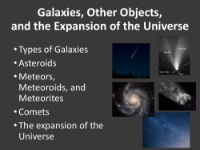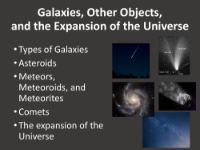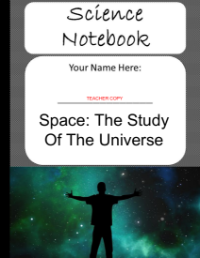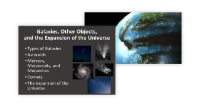COMET, METEOR OR ASTEROID - The REAL difference.
Video
Science
+1
Science
6th Grade - 8th Grade
Premium

B
Beautiful Science
Science Resource Description
What is a shooting star exactly? There is a vast amount of rocks and debris floating around in space. Around 100 tons of it falls to earth every day. You might have been lucky enough to have seen a shooting star, but do you know whether it is a comet, meteorite or an asteroid?
-----------------
Do you want to learn how to animate like us or Kurzgesagt? We have teamed up with Skillshare to offer you 2 free months of learning. Stream more than 18,000 online classes on subjects like design, animation, (Kurzgesagt have classes on here, check it out!), business, and tech. Use the referral link here - https://skillshare.eqcm.net/DZEOo
--------------------
Comet, meteor or Asteroid?
Intro
There is a vast amount of rocks and debris floating around in space. Around 100 tons of it falls to
earth every day. You might have been lucky enough to have seen a shooting star, but do you know
whether it is a comet, meteorite or an asteroid?
what is the difference between these 3 objects? Why are we landing satellites on asteroids and
could life have been brought to earth on one of these rocks?
Main
Comet
A comet (also called a dirty snowball) is essentially ball of ice, rock and dust that orbits the sun,
ranging in size from around 1km to 20km.
Astronomers believe they are leftovers from the early formation of the solar system that reside in
one of two places on the very outskirts of the solar system; The Kuiper belt and the Oort Cloud.
These two areas are made up of small icy bodies (and Pluto) of frozen gases such as methane,
ammonia, nitrogen and water mixed with rock and dust. Occasionally a comets orbit will be altered
by a gravitational tug of another large object or through a collision with another body that might
send it into the inner solar system or sometimes even straight towards the sun.
As a comet starts to move closer the sun, it heats up and ice starts to evaporate and form a cloud
around the nucleus. Solar winds from the sun push the cloud to make a tail on the comet, also called
a coma. The coma creates a spectacular light show for us on earth and these tails can reach up to
150km in length.
Asteroid
Nearly all Asteroids are odd shaped chunks of rock that orbit the sun in the asteroid belt between
mars and Jupiter. Some though are thought to be made of metals like nickel and Iron.
The asteroid belt is thought to be either leftover mass from a failed planet forming due to the close
gravity pull of Jupiter or the leftovers from a planet that broke up due to a collision.
They come in sizes from a few meters to just under a 1000kilometers wide. Ceres is the largest we
have ever found and is 960km wide which is about as wide as Texas and big enough to be classed as
a dwarf planet. Some asteroids also have their own moons!
Also if you condensed all of the asteroids in the belt together they would still be smaller than our
moon.
Meteoroid
Space debris smaller than asteroids are called meteoroids. These can be as big as a few meters and
as small as a grain of sand. They are usually bits of asteroids that have collided or leftover debris
from a comet.
When a small meteoroid gets close enough to enter in the Earth’s atmosphere it starts to burn up
completely and creates a dazzling trail of light due to the air resistance it encounters. This is called a
meteor, or as we sometimes call them, shooting stars.
Every year around mid July the Earth’s orbit takes us through the dust and debris left behind by a
comet. This is called the Perseid meteor shower and creates an incredible display of shooting stars
with around 80 shooting stars an hour. You can find out more about this and how to view the
spectacle in the link at the end of the video or in the description below.
90-95% are vaporized n their approach to earth but when a rock survives this and hits the earth’s
surface, it is called a meteorite. They are usually about the size of a pebble but we have found a
3-metre-wide 66 ton tablet shaped meteorite in Namibia that fell about 80,000 years ago.
Instagram - https://www.instagram.com/beautiful_sci/
Twitter - https://www.twitter.com/BeautScienceVid
Facebook - https://www.facebook.com/beautifulsci...
#comet #meteor #asteroid
Unlimited access to 30,000+ resources
All subjects
National Curriculum Coverage
Award-winning content
Explore other content in this scheme
Part of a lesson by Teach with Fergy
Other resources in this lesson

Galaxies, Other Objects and the Universe - Student Presentation
Resource
Science
+1
6th Grade - 8th Grade

Galaxies, Other Objects and the Universe - Teaching Presentation
Resource
Science
+1
6th Grade - 8th Grade

Galaxies and the Universe - Exit Ticket
Resource
Science
+1
6th Grade - 8th Grade

KT Asteroid Impact
Resource
Science
+1
6th Grade - 8th Grade

Meteor Explosion of Atomic Strength Injures 1,000 in Russia
Resource
Science
+1
6th Grade - 8th Grade

First Second Of The Universe
Resource
Science
+1
6th Grade - 8th Grade

What Is a Redshift?
Resource
Science
+1
6th Grade - 8th Grade

Galaxies, Other Objects and the Universe - Student Lesson Outline
Resource
Science
+1
6th Grade - 8th Grade

Notebook
Resource
Science
+1
6th Grade - 9th Grade

Notebook
Resource
Science
+1
6th Grade - 9th Grade
This website uses cookies to enhance the user experience.
To get more information about these cookies check our

